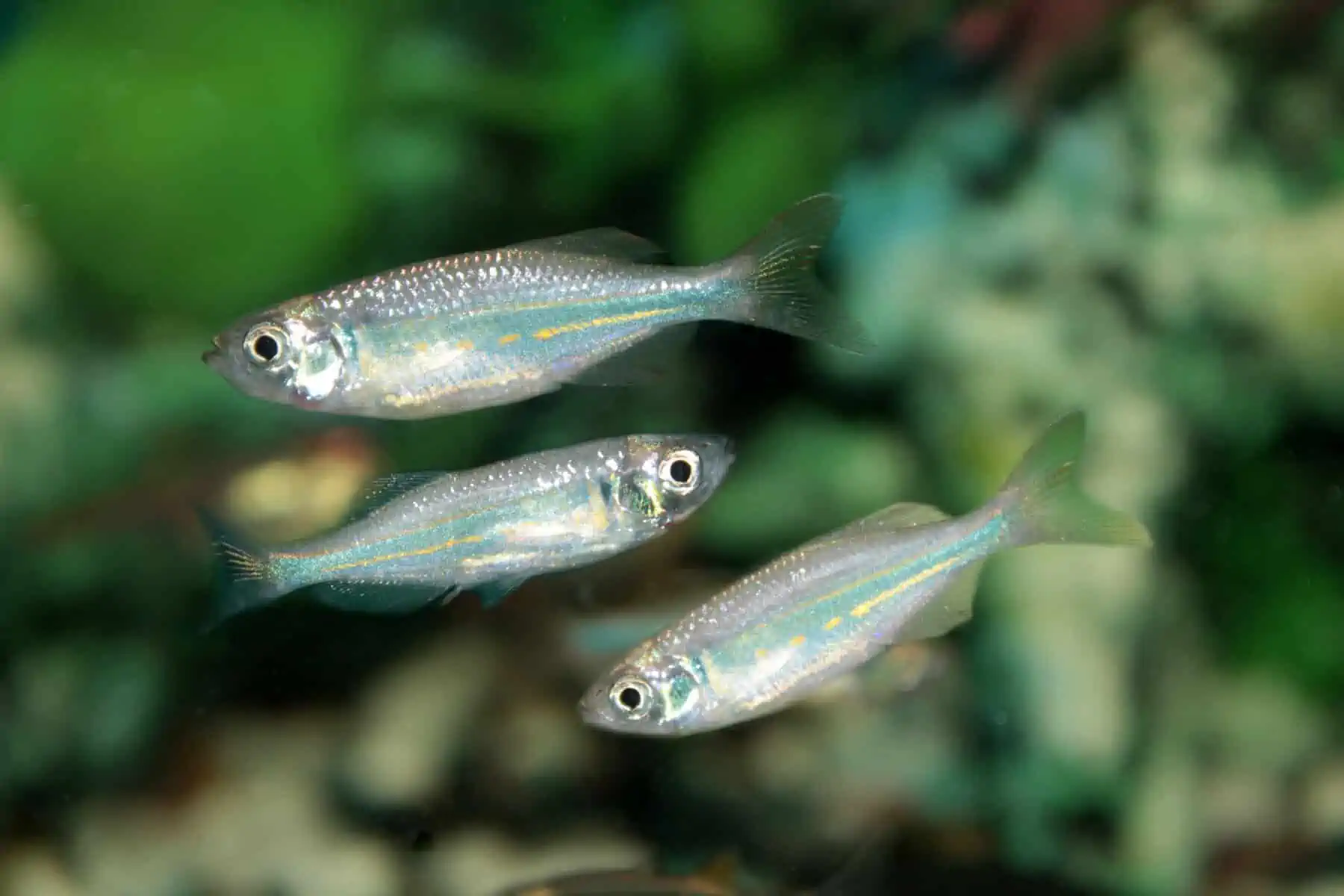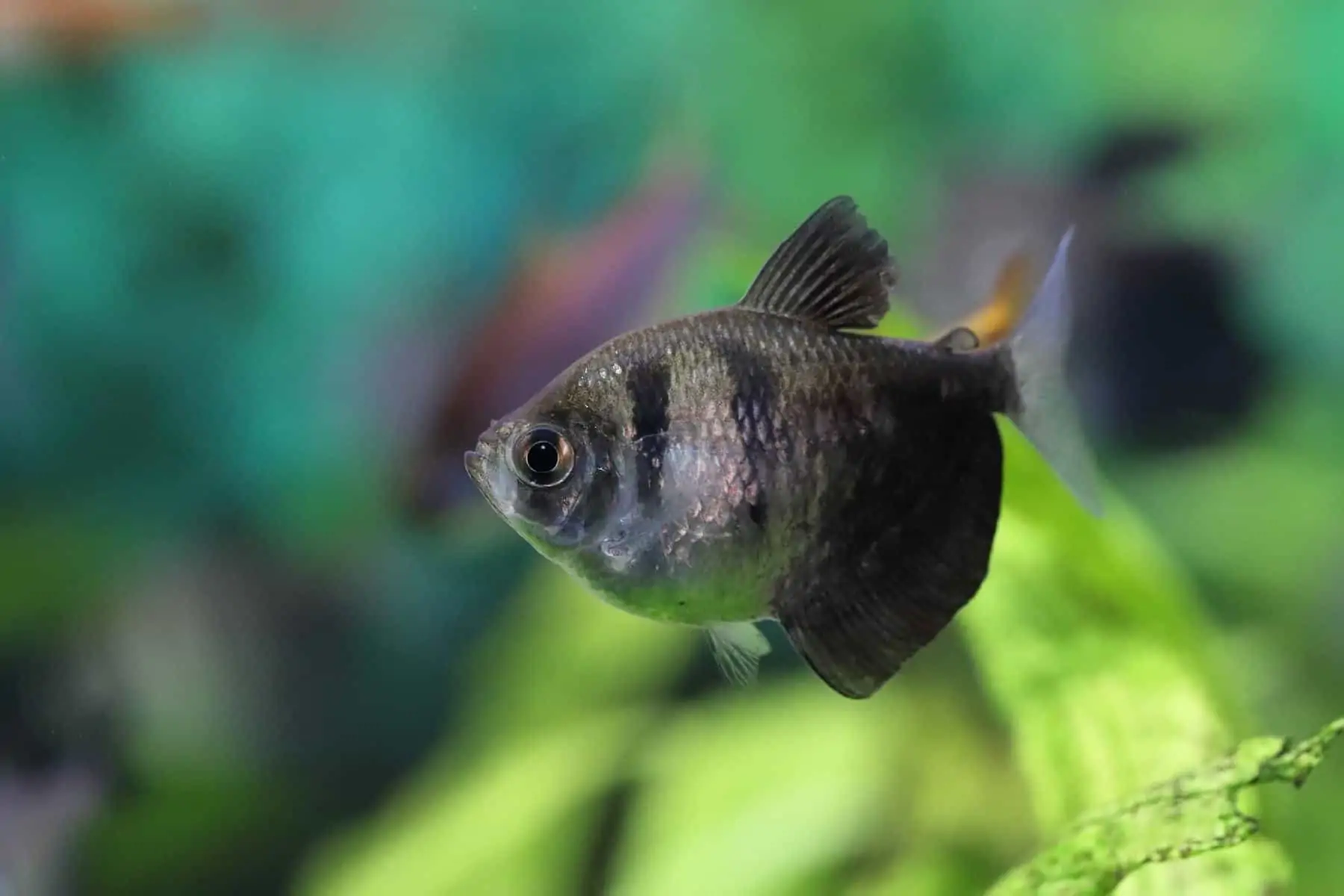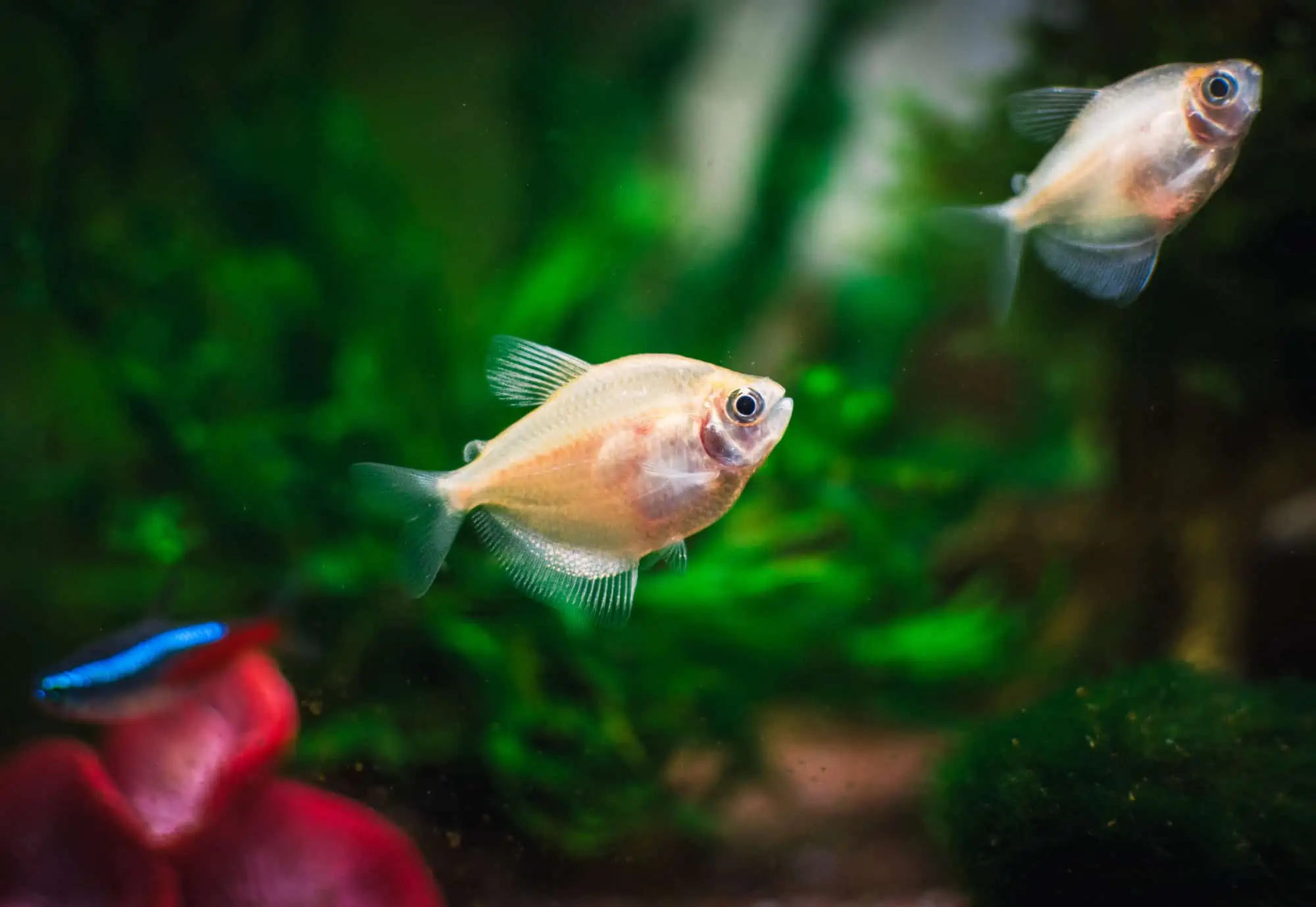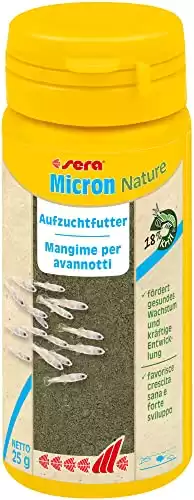[ad_1]
The white skirt tetra is a beautiful tropical fish for the freshwater community tank. The graceful shape and attractive schooling behavior of this fish make it a popular choice for aquarium hobbyists around the world.
Here we’ll take an in-depth look at these translucent fish, how to best care for them, and also discuss the important fin-nipping issue! Let’s dive in.
White Skirt Tetra Species Overview
| White Skirt Tetra Info | |
|---|---|
| Scientific name | Gymnocorymbus ternetzi |
| Size | 2 inches |
| Temperament | Peaceful |
| Minimum Tank Size | 10 gallons |
| Temperature | 73°F to 81°F |
| pH | 6 to 7.5 |
| Diet | Omnivore |
Origin and Background
White skirt tetras don’t actually exist in the wild. They are a captive-bred albino version of the black tetra, also known as the black skirt or black widow tetra (Gymnocorymbus ternetzi).
Black tetras are originally from still and slow-moving waters of South America. The species tends to spend time in shady places, which may explain why they developed their dark colors for camouflage purposes.
The bright albino white skirt tetra might, therefore, not live long if released into the wild!
Appearance and Size
White skirt tetras look much like black skirt tetras, except they lack any color pigment. The entire body, including its fins, is a translucent silvery white color, although it may also appear cream-colored or slightly yellow, depending on the tank’s lighting.
Like the black tetra, they have an attractive round outline reminiscent of their carnivorous cousin, the red-bellied piranha! However, they don’t grow as large as piranhas – these nano fish usually only grow to around 2 inches (5cm) in length, although large females can sometimes reach 2.5 inches (6.5cm)
White Skirt Tetra Color Variations
Because this fish is a plain, translucent color, it has become a target for fish dying. This cruel practice has produced many different colors of this species, which are marketed under different exotic names.
Strawberry tetra, rainbow tetra, and blueberry tetra are just a few of the names that salesmen have coined for these mistreated fish. It’s important to understand that these methods are extremely unethical and are reported to kill many fish.
Besides that, any “painted fish” you buy is likely to be much weaker and more likely to suffer from health problems or die prematurely than regular white skirt tetra.
White Skirt Tetra Care Guide
Tank Size
White skirt tetras may only grow to 2 inches in length, but they are schooling fish that need to be kept in large groups. In the wild, they’d form schools of hundreds or thousands of fish, so in an aquarium, it’s best to keep them in groups of at least eight, with six being the very minimum.
I’d never recommend keeping any tetra in a tank smaller than 20 gallons since they need plenty of free swimming space to display their natural schooling behavior.
A 20-gallon tank would, therefore, be the minimum I’d recommend for even six white skirt tetra. Since the white skirt tetra needs around 2-2.5 gallons per fish, you’ll need an even bigger tank if you want to keep more than 10 of them or plan to keep them with several other fish.
Tank Environment
As I mentioned in the introduction, the white skirt tetra is simply a color morph of the black skirt tetra. Since this species lives in shady environments with plenty of plants, I’d recommend providing a similar setup in your aquarium.
Floating plants such as Amazon Frogbit and Water Lettuce are excellent for providing dappled shade underneath, and you might find that your white skirt tetras enjoy spending time under the shadow of these plants.
Other aquarium plants that do well in low light, like Java fern, Java moss, Amazon sword, and Anubias, will provide excellent hiding places for white skirt tetra and make the tank look lush, beautiful, and like a natural South American habitat.
Water Temperature
White skirt tetras are tropical fish that definitely require an aquarium heater. They will accept a wide range of water temperatures, from 73-81°F, so are compatible with almost all tropical aquarium fish in this way.
It’s important to note that white skirt tetras are sensitive to sudden changes in water temperature, so acclimatizing them properly in a new tank is essential to avoid thermal shock.
Water Parameters
As well as tolerating a wide range of temperatures, white skirt tetras do fine in a wide range of water parameters.
Their ideal pH range is between 6 and 7.5, but they can tolerate slightly more acid or alkaline water conditions. Anywhere up to 15 dGH is fine for water hardness.
Because their wild counterparts, black skirt tetras, come from amber-colored waters that are stained with tannins, you might like to produce the same effect in your fish tank. You can introduce tannins to your tank by adding pieces of hardwood, driftwood, or Indian almond leaves.
Tannins also reduce the water’s pH, and some people believe they’re beneficial to the health of fish from similar natural habitats.
Filtration
White skirt tetras need reasonably high water quality to remain happy and healthy, so a good aquarium filter is essential.
Hang-on-back filters, internal power filters, or a canister filter are all excellent options, but you should take care not to overwhelm these fish with a strong current.
Because they come from slow-moving rivers, white-skirt tetras can get stressed by a strong filter output. Some filters allow you to manually adjust the flow rate. On other filter models, you can reduce the water current by using an aquarium spray bar or lily pipe.
Feeding
White skirt tetras are unfussy in their eating habits and will accept almost any type of tropical aquarium food.
Dried foods like flake foods are readily accepted, but dried fish foods should always be supplemented with fresh and frozen foods such as bloodworms, tubifex worms, daphnia, brine shrimp, mosquito larvae, and vegetable supplements.
As usual, feed your fish twice a day, with no more than they can eat in 2 minutes. Overfeeding is one of the most common causes of water quality and health problems in aquarium fish. Even if your fish seem hungry, be careful not to feed too much!
Compatible Tank Mates
White skirt tetras are generally fairly peaceful fish, although they have been noted for nipping fins (see notes below).
In a community tank, they look fantastic alongside more colorful tetras, such as the neon tetra, ember tetra, and cardinal tetra. Other schooling fish like Danios and Rasboras are good options, too.

Because white skirt tetras are fairly quick and hardy, they could also be kept with mildly aggressive fish. Semi-aggressive dwarf cichlids like ram cichlids, kribensis, or rainbow cichlids should be compatible in larger tanks.
Surface-dwelling fish, like a pair of dwarf gouramis, and bottom-dwelling fish, like Corydoras catfish or plecos, should also make amicable companions.
Fin Nipping
It must be noted that black and white skirt tetras have a reputation for nipping the fins of other species of fish, especially those with long fins! This ‘fin nipper’ reputation has come from many aquarists reporting these fish nipping at their angelfish, guppies, and even each other.
Fin nipping in white skirt tetras is normally a result of stressed fish that are being kept in an overcrowded tank or in a group that’s too small.
To reduce aggressive behavior, keep white skirt tetras in a larger group. This will make them feel safer and disperse the fin-nipping behavior between each other so that no fish gets seriously injured.
However, because of their potential to nip fins, I’d advise against keeping white skirt and black skirt tetras with delicate species like guppies and never with betta fish.
Can You Mix White Skirt Tetras With Black Skirt Tetras?

Because white and black skirt tetras are officially the same species, some people have tried mixing them.
While some aquarists have reported that they school together ok, others say that the two don’t mix well and will sometimes bicker.
This likely depends on the character of each group of fish. Just as neon tetra will sometimes, but not always, school with cardinal tetra and green tetra, it seems to depend on several factors.
In summary, successful schooling between two tetra species or even varieties is possible but can never be guaranteed!
Health and Disease
White skirt tetras are not particularly prone to diseases, but they remain susceptible to the same infections and health conditions of other fish when tank conditions are poor.
Ich, velvet, and flukes are common parasitic diseases that can lie dormant in an aquarium for years until a weakened fish or very poor water quality offers them a chance to strike.
Similarly, bacterial and fungal infections like columnaris and water molds only tend to affect fish that are already in a vulnerable state.
As mentioned earlier, white skirt tetras are prone to nipping each other’s fins when kept in small groups or when stressed. Nipped fins can lead to fin rot – a bacterial infection that can later invade the rest of the body.
Keeping white-skirt tetras in groups of eight or more, with plenty of hiding places in a clean tank, is the best defense against stress and unnecessary diseases.
Sexual Dimorphism
There are some subtle differences between male and female white skirt tetras. Females are usually larger than males and have a rounder body.
Male white-skirt tetras tend to be smaller, slimmer, and more angular, with a more pointed dorsal fin.
Breeding White Skirt Tetra
If you want to breed white skirt tetra, you must set up a separate breeding tank.
To prime them for breeding, keep them in groups with a few more males than females or as a single pair. Feed them fresh, high-protein foods like bloodworms.
Like other tetras, white-skirt tetras are free spawning, meaning they scatter their eggs and sperm into open water near bushy plants. Once the sticky, fertilized eggs have attached themselves to the leaves of the plants, the parents and any other fish need to be removed to prevent them from eating the eggs.
Feed the fry on a high-quality fry infusoria food, and progress to baby brine shrimp when they’re big enough.
Lifespan
White skirt tetras will typically live to around 2-3 years in age, but in exceptional conditions, they can sometimes exceed 5 years in captivity.
For them to reach their maximum lifespan, their diet, water quality, and quality of care must be of the highest order.
White Skirt Tetra Tank Maintenance

Some top tips for keeping your white skirt tetras in tip-top condition!:
White Skirt Tetra Buying Guide
White skirt tetras can be sourced from specialist stores, typically for between $4-10 each. They may not be as easy to find as black skirt tetras, so you can always try asking your local pet stores if they’d be interested in sourcing some for you.
As we mentioned at the start, always avoid colored versions of these fish since they will have been dyed using inhumane methods that are detrimental to their health.
Final Thoughts
White skirt tetras are simply a white form of the black skirt tetra and fulfill the same role as a beautifully-shaped and fairly peaceful species for the tropical community tank.
With the right care and attention, a school of white skirt tetras will grace your tropical aquarium for several years. Just be sure that you keep them away from fish with long fins and always in large groups, preferably of eight or more.
[ad_2]
Source link

